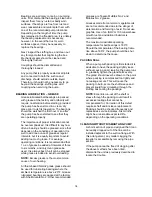
14
Pressure Gauges
Properly sized pressure gauges should be
installed in both the suction and discharge
nozzles in the gauge taps provided. The
gauges will enable the operator to easily
observe the operation of the pump, and also
determine if the pump is operating in
conformance with the performance curve. If
cavitation, vapor binding, or other unstable
operation should occur, widely fluctuating
discharge pressure will be noted.
Pump Insulation
On chilled water applications most pumps are
insulated. As part of this practice, the pump
bearing housings should not be insulated
since this would tend to “trap” heat inside the
housing. This could lead to increased bearing
temperatures and premature bearing failures.
STUFFING BOX LUBRICATION
Contaminants in the pumped liquid must not
enter the stuffing box. These contaminants
may cause severe abrasion or corrosion of
the shaft, or shaft sleeve, and rapid packing
deterioration; they can even plug the stuffing
box flushing and lubrication system. The
stuffing box must be supplied at all times with
a source of clean, clear liquid to flush and
lubricate the packing or seal. It is important to
establish the optimum flushing pressure that
will keep contaminants from the stuffing box
cavity. If this pressure is too low, fluid being
pumped may enter the stuffing box. If the
pressure is too high, excessive packing wear
may result; and extreme heat may develop in
the shaft causing higher bearing
temperatures. The most desirable condition,
therefore, is to use a seal water pressure 15-
20 psig above the maximum stuffing box
pressure.
PACKING
Standard pumps are normally packed before
shipment. If the pump is installed within 60
days after shipment, the packing will be in
good condition with a sufficient supply of
lubrication. If the pump is stored for a longer
period, it may be necessary to repack the
stuffing box. In all cases, however, inspect
the packing before the pump is started.
NOTE:
Packing adjustment is covered in the
MAINTENANCE section of this manual.
On some applications, it is possible to use
internal liquid lubrication (pumped liquid) to
lubricate packing. Only when all of the
following conditions prevail, can this be done:
1. Liquid is clean, free from sediment and
chemical precipitation and is compatible
with seal materials.
2. Temperature is above 32°F and below
160°F.
3. Suction pressure is below 75 psig.
4. Lubrication (pumped liquid) has lubricating
qualities.
5. Liquid is non-toxic and non-volatile.
When the liquid being pumped contains
solids or is otherwise not compatible with
packing materials, an outside supply of seal
liquid should be furnished. In general,
external-injection liquid (from an outside
source) is required when any of the above
conditions cannot be met.
The standard stuffing box consists of rings of
packing (see assembly section for number of
rings), a seal cage, a bushing and a gland. A
shaft sleeve which extends through the box
and under the gland is provided to protect the
shaft.
A tapped hole is supplied in the stuffing box
directly over the seal cage to introduce a
clean, clear sealing medium. The stuffing box
must, at all times, be supplied with sealing
liquid at a high enough pressure to keep the
box free from foreign matter, which would
quickly destroy the packing and score the
shaft sleeve.
Only a sufficient volume of sealing liquid to
create a definite direction of flow from the
stuffing box inward to the pump casing is
required, but the pressure is important. Apply
seal water at a rate of approximately .25
GPM at a pressure approximately 15 to 20
psig above the suction pressure.
(Approximately one (1) drop per second.)
One recommended method to minimize error
in regulating flushing water is a “Controlled
Pressure System” (Figure 9). It is important to
set the pressure reducing valve adjusted to a
value slightly exceeding the maximum
stuffing box operating pressure (assuming it
is reasonably constant). A flow indicating
device will detect a failing of the bottom
packing rings allowing leakage in the pump.
External sealing liquid should be adjusted to
the point where the packing runs only slightly
warm, with a very slow drip from the stuffing















































